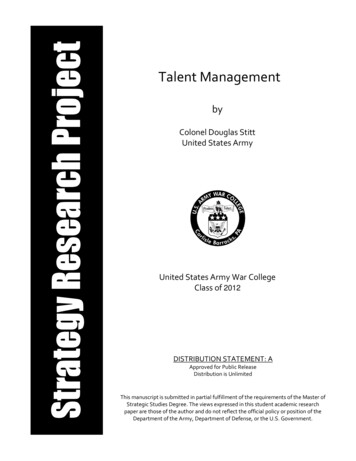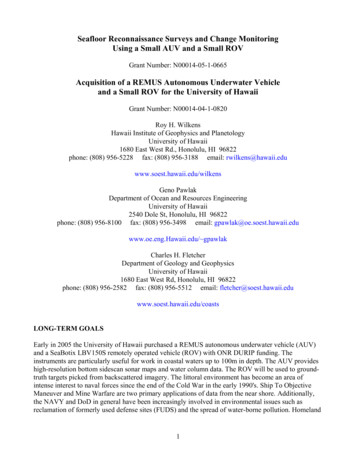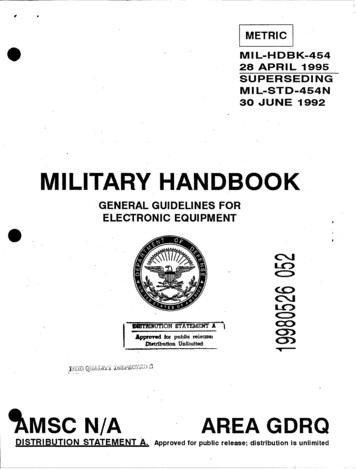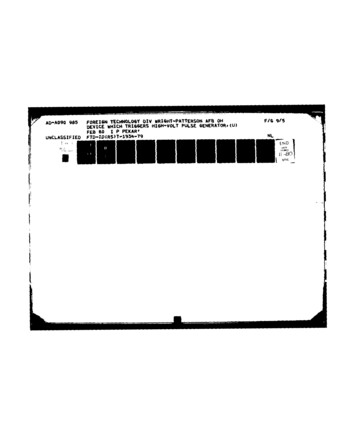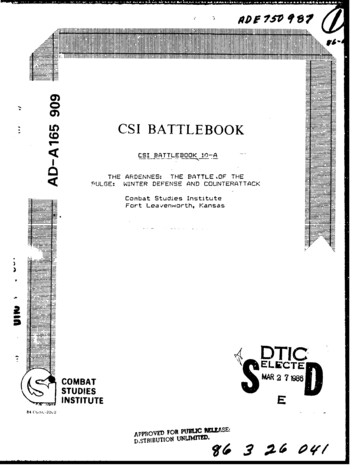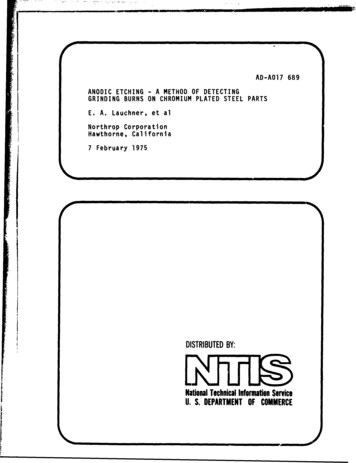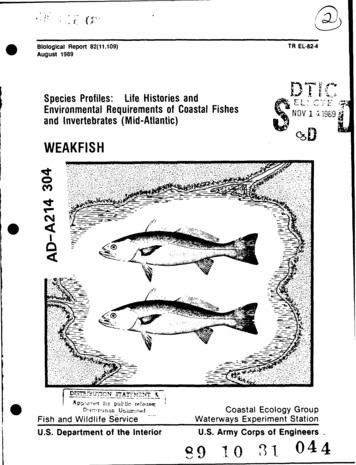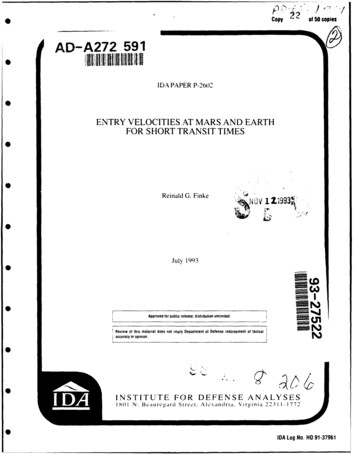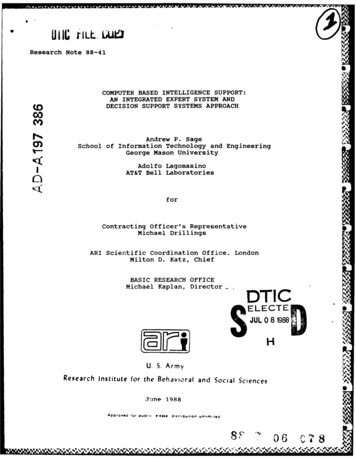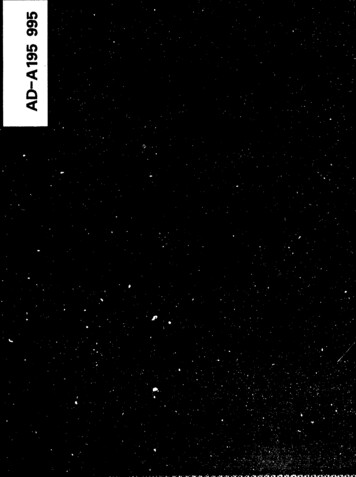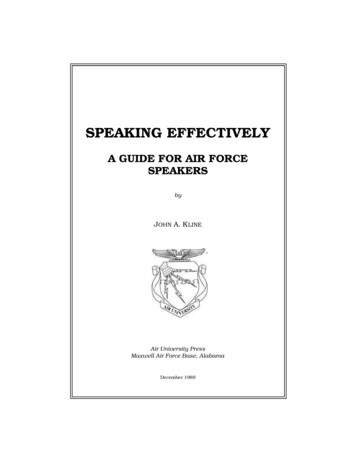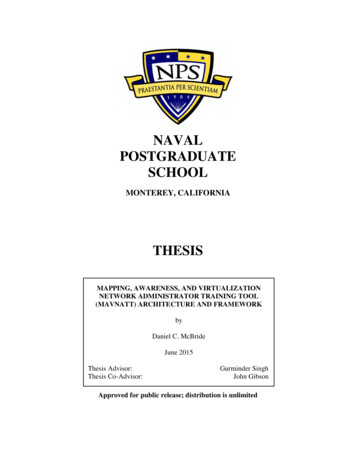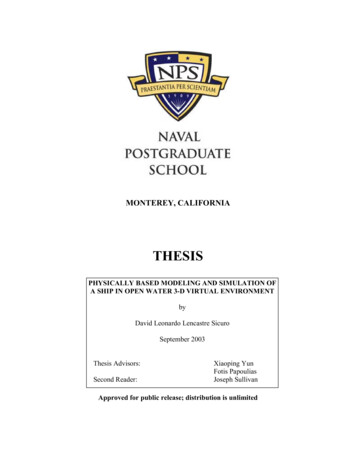
Transcription
MONTEREY, CALIFORNIATHESISPHYSICALLY BASED MODELING AND SIMULATION OFA SHIP IN OPEN WATER 3-D VIRTUAL ENVIRONMENTbyDavid Leonardo Lencastre SicuroSeptember 2003Thesis Advisors:Second Reader:Xiaoping YunFotis PapouliasJoseph SullivanApproved for public release; distribution is unlimited
THIS PAGE INTENTIONALLY LEFT BLANK
REPORT DOCUMENTATION PAGEForm Approved OMB No. 0704-0188Public reporting burden for this collection of information is estimated to average 1 hour per response, includingthe time for reviewing instruction, searching existing data sources, gathering and maintaining the data needed, andcompleting and reviewing the collection of information. Send comments regarding this burden estimate or anyother aspect of this collection of information, including suggestions for reducing this burden, to Washingtonheadquarters Services, Directorate for Information Operations and Reports, 1215 Jefferson Davis Highway, Suite1204, Arlington, VA 22202-4302, and to the Office of Management and Budget, Paperwork Reduction Project(0704-0188) Washington DC 20503.1. AGENCY USE ONLY (Leave blank)2. REPORT DATE3. REPORT TYPE AND DATES COVEREDSeptember 2003Master’s Thesis4. TITLE AND SUBTITLE: Physically Based Modeling and Simulation of a Ship 5. FUNDING NUMBERSin Open Water 3-D Virtual Environment6. AUTHOR(S) David Leonardo Lencastre Sicuro7. PERFORMING ORGANIZATION NAME(S) AND ADDRESS(ES)8. PERFORMINGNaval Postgraduate SchoolORGANIZATION REPORTMonterey, CA 93943-5000NUMBER9. SPONSORING /MONITORING AGENCY NAME(S) AND ADDRESS(ES)10. SPONSORING/MONITORINGN/AAGENCY REPORT NUMBER11. SUPPLEMENTARY NOTES The views expressed in this thesis are those of the author and do not reflect the officialpolicy or position of the Department of Defense or the U.S. Government.12a. DISTRIBUTION / AVAILABILITY STATEMENT12b. DISTRIBUTION CODEApproved for public release; distribution is unlimited13. ABSTRACT (maximum 200 words)This thesis addresses the development of a physically based modeling simulator for a ship in a 3-D virtualenvironment to be used in naval tactical training systems. The objective is to develop a computer simulation program in which physical models are implemented in order to achieve a realistic representation of a ship in a virtualenvironment considering its physical features in the presence of environment conditions including waves, oceancurrent, wind, fog and day/night issues. The simulator was developed by integrating five marine models with a virtual ocean environment created with a visual simulation builder tool. The marine models include a maneuveringmodel, a wave model, a wind model and an ocean current model. The numerical results from another complexwave model were also combined using linear interpolation to increase the realism level of the simulator. The resultof this thesis shows that the integration of multiple models from different sources is a feasible approach to meetthe application requirements. The result also indicates that the use of the interpolation technique to take advantageof complex models yields a simulator with acceptable level of realism while imposing very low computationalload in the application program.14. SUBJECT TERMSPhysically Based Modeling, 3-D Virtual Environment, Ship Maneuvering Simulator, EnvironmentDisturbances17. SECURITYCLASSIFICATION OFREPORTUnclassified18. SECURITYCLASSIFICATION OF THISPAGEUnclassifiedNSN 7540-01-280-550015. NUMBER OFPAGES11116. PRICE CODE19. SECURITY20. LIMITATIONCLASSIFICATION OFOF ABSTRACTABSTRACTUnclassifiedULStandard Form 298 (Rev. 2-89)Prescribed by ANSI Std. 239-18i
THIS PAGE INTENTIONALLY LEFT BLANKii
This thesis done in cooperation with the MOVES InstituteApproved for public release; distribution is unlimitedPHYSICALLY BASED MODELING AND SIMULATION OF A SHIP IN OPENWATER 3-D VIRTUAL ENVIRONMENTDavid Leonardo Lencastre SicuroTechnologist Senior, Brazilian NavyB.S., Rio de Janeiro Federal University, 1983Submitted in partial fulfillment of therequirements for the degree ofMASTER OF SCIENCE IN ELECTRICAL ENGINEERINGandMASTER OF SCIENCE IN MODELING, VIRTUAL ENVIRONMENTS ANDSIMULATIONfrom theNAVAL POSTGRADUATE SCHOOLSeptember 2003Author:David Leonardo Lencastre SicuroApproved by:Xiaoping YunThesis AdvisorFotis A. PapouliasThesis AdvisorJoseph A. SullivanSecond ReaderJohn P. PowersChairman, Department of Electrical and Computer EngineeringRudolph P. DarkenChairman, Department of Modeling, Virtual Environments andSimulationiii
THIS PAGE INTENTIONALLY LEFT BLANKiv
ABSTRACTThis thesis addresses the development of a physically based modeling simulatorfor a ship in a 3-D virtual environment to be used in naval tactical training systems. Theobjective is to develop a computer simulation program in which physical models are implemented in order to achieve a realistic representation of a ship in a virtual environmentconsidering its physical features in the presence of environment conditions includingwaves, ocean current, wind, fog and day/night issues. The simulator was developed by integrating five marine models with a virtual ocean environment created with a visualsimulation builder tool. The marine models include a maneuvering model, a wave model,a wind model and an ocean current model. The numerical results from another complexwave model were also combined using linear interpolation to increase the realism level ofthe simulator. The result of this thesis shows that the integration of multiple models fromdifferent sources is a feasible approach to meet the application requirements. The resultalso indicates that the use of the interpolation technique to take advantage of complexmodels yields a simulator with acceptable level of realism while imposing very low computational load in the application program.v
THIS PAGE INTENTIONALLY LEFT BLANKvi
TABLE OF CONTENTSI.INTRODUCTION.1A.BACKGROUND .1B.PROBLEM STATEMENT .2C.THESIS OUTLINE.3II.OBJECTIVES OF SIMULATION SYSTEM .5A.WHAT TO MODEL? .51.Survey.52.Results and Analysis .6B.MODEL COMPLEXITY TRADEOFF.7III.SIMULATION SYSTEM OVERVIEW .9A.MAIN FEATURES .9B.SYSTEM MODULES.9C.VALIDATION OF THE MODELS .11IV.THE VIRTUAL ENVIRONMENT MODULE.13A.THE VEGA SYSTEM .131.General Description .132.The Vega Marine Module .133.Special Effects.154.Vega Coordinate System .15V.THE SHIP MOTION MODULE.17A.THEORETICAL BACKGROUND .171.Degrees of Freedom and Notations .172.Coordinate Frames .183.Ship Motion Equations .184.Non-Dimensional Parameters .205.Hydrodynamics Derivatives.216.The Environment Disturbances.22B.THE MANEUVERING MODEL.231.Container Ship Main Features .232.Nonlinear Equations of Motion .243.The Model Representation .284.Rudder Saturation and Dynamics.305.Shaft Speed Saturation and Dynamics.306.Interaction with Other Modules .317.Validation of the Maneuvering Model .33C.THE WAVE MODEL I .381.General Description .392.Wave Model Coordinate System .403.Wave Model Tables.41a.Obtaining SHIPMO.OUT File .41vii
D.E.F.b.Converting to waveModelTables.h File.444.Interaction with Other Modules .445.Validation of the Wave Model I.48THE WAVE MODEL II .541.Description.542.Interaction with Other Modules .553.Validation of the Wave Model II .55THE WIND MODEL.561.Description.562.Interaction with Other Modules .583.Validation of the Wind Model .59THE OCEAN CURRENT MODEL.601.Description.602.Interaction with Other Modules .613.Validation of the Ocean Current Model .61VI.THE SIMULATION PROGRAM.63A.GENERAL DESCRIPTION .63B.THE SIMULATION CONTROLLER BLOCK .641.Initialization.652.Main Loop.653.Data Acquisition.654.Shared Memory Transfer I .665.Input New Settings.666.Positions and Orientations .677.Rendering Control .67C.THE CONTAINER SHIP BLOCK.671.Initialization.672.Main Loop.673.Shared Memory Transfer II .684.Coupled Models.695.Ocean Current Model.696.Wave Model I .697.Numerical Integrator.698.Coordinate Frame Converter .70VII.OPERATION OF THE SIMULATOR.71A.GETTING STARTED .71B.COMMANDS .71VIII. CONCLUSIONS AND RECOMMENDATIONS.75APPENDIX A. SURVEY.77APPENDIX B. CONTAINER SHIP BODY PLAN [AFTER REF. 10] .79APPENDIX C. SHIPMO.IN INPUT FILE .81APPENDIX D. SHIPMO.OUT OUTPUT FILE .83viii
LIST OF REFERENCES .89INITIAL DISTRIBUTION LIST .91ix
THI
This thesis addresses the development of a physically based modeling simulator for a ship in a 3-D virtual environment to be used in naval tactical training systems. The objective is to develop a computer simulation pro-gram in which physical models are implemented in order to achieve a realistic representation of a ship in a virtual
